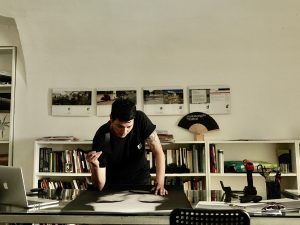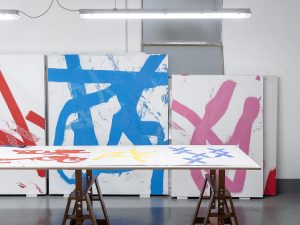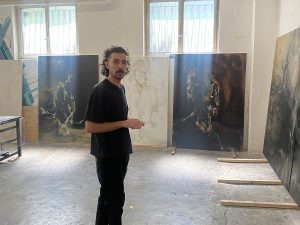In his 1922 canvas Au rendez-vous des amis, Max Ernst records the lively cultural ferment that accompanied the theorisation of the Surrealist movement. Through the artists and intellectuals portrayed in this work, we can clearly see urgency and the centrality of an all-encompassing, constant dialogue. In the German artist’s work, we witness the creation of a real value system, where knowledge circulated that would later be theorised so that it could be spread to the outside world.
With the nostalgia typical of those who have never really lived through an era, the younger generations often imagine these great avant-garde movements of the past, and the avant la lettre critics, as immersed in a stimulating process of dialogue that produced theoretical systems. Similarly, militant criticism is thought of as a possibility for artistic reflection that flourished at a time when the power of genuinely cultural processes was clear and tangible, and it was possible to conceive of a systematising thought distant from power and in open opposition to the sterile law of the market.
Some sixty years after Ernst’s work, in a completely different cultural climate and geographical coordinates, in 1980–81 Carlo Maria Mariani produced his La costellazione del Leone (La Scuola di Roma). It offered another tangible sign of the bond between artists and theorists in relation to certain crucial themes in which mutual recognition is fundamental — and perhaps even more so, recognition of one’s role.[1]
The most glaring difference between the two paintings lies in the fact that, at the time that the second was created, the debate was gradually expanding to the market. This is, indeed, evidenced by the presence of influential dealers and gallery owners (such as Gian Enzo Sperone, who would exhibit this very work in a solo exhibition of this artist) in the work inspired by Raphael’s Parnassus. It was in those years that the market began to occupy a primary position in the art system — one that it had never held up till that point.
Today, it is clear how far visual art has aligned its production logics with those of the other performing arts sectors, in turn leading to similar consumption dynamics. This is also connected to an acceleration of the steps of an artist’s career, which is having an extremely strong impact on the younger generations. This development leads to the need to disseminate one’s work at a heightened pace, almost exclusively by resorting to the ‘exhibition’ device. It also leads to an exponential acceleration of interest in various micro-themes, not always born of reflections matured among artists or theorists, but rather responding to purely commercial needs.
Criticism today thus seems not only functional to power, but also subordinate to the quest for personal success, losing its original role of constructing (translating and disseminating) a pure discourse around art. Textual apparatuses thus become a side note, not the result of a dynamic exchange, and criticism becomes an appendix to the process of defining an exhibition, with a specific scope quite different from the one that it had in the past.
From the 1990s onwards, the disintegration of the major theoretical movements and the assertion of individuality in the artistic field led to a total rethinking of the value system as well as a questioning of the art system. This process was accompanied by a change of status and the hyperspecialisation of certain figures.
Not by accident, in the ‘golden years’ of militant criticism, the practice of curating and criticism often overlapped, without there being any clear division between the disciplines. But today, curator and critic are two distinct and autonomous professions; moreover, we are witnessing the massive spread of new curatorial practices which do not necessarily involve any lengthy critical exchange. This process of gradual estrangement is well evidenced by the fact that there are specific schools and training courses for curators, but not for aspirant critics, and that theoretical study is, in most cases, relegated to a historical perspective and never to future development. This results in a major training gap that does not allow the young generations to draw on new methodologies and tools for the critical reading and reinterpretation of contemporary phenomena.
If criticism has gradually abandoned the formal circuit of the exhibition space and of education, it is also true that, with the passing of the years, the custom of frequenting informal spaces in which to discuss art has also disappeared. In the past, even these catalysts had a certain importance (let us think, again referring to a work, of Guttuso’s Il Caffè Greco, 1976) and facilitated encounters and proactive exchanges. This dimension only fuels the imaginary of an artistic past characterised by the world’s total permeability towards cultural and creative processes, which today seem relegated to a sphere totally alien to everyday life.
If the spaces for engagement are declining, it is to be expected that the era of militant criticism will be approached with a sweet melancholy. It may be imagined as an irretrievably lost world, as an active discussion among ‘fellow travellers’ that was theorised and then disseminated by some charismatic trailblazer or spokesperson. It is an activism that finds its greatest romanticisation in Italy with figures such as Germano Celant and Achille Bonito Oliva, holding up for a few more decades until its obvious decay in our own time.
Once the centrality of public debate and of dialogue between artist has been recognised, and once it has been established how the market and the speed of systemic changes have shifted the balance by derailing the role of criticism, we can doubtless then say that the generational and militant element of criticism can survive precisely on the basis of bodies and spaces that operate outside the logics of subordination.
In a climate in which young theorists — but even more so, young artists — feel disaffection towards the practice of criticism, it needs asking whether the younger generations are looking for an active exchange. But what needs asking even more is whether there are indeed shared currents of thought that can be intercepted and theorised.
It is, in fact, unthinkable to address a discourse on militant criticism without taking into account its core, namely the artists and their works, all the more so since it is they who could reaffirm the role of criticism, reasserting its importance.
One hope for the conception and dissemination of new critical methodologies lies precisely in the artist-run spaces or artist-run magazines that arewidely active throughout Italy. Which is to say, in those formally or informally constituted contexts where artists work together, having exchanges on different issues of contemporary importance and weaving webs of relations capable of intercepting the different personalities that gravitate around them.
Often in these sites, however, considerations are produced that go no further than making choices for exhibitions, and which lack the strength to achieve ‘systematisation’. This may be the result of many different factors, primarilymeaning lack of theoretical or economic tools. This is why there is a growing intensification of documentation and archiving work, in a gradual replacement of organic critical-textual apparatuses.
Despite these conditions, even informal exchanges between the new generations of artists and theorists may have the potential to produce new rituals and critical methodologies, capable of ‘setting’ new styles.
In short, physical, immaterial or hybrid spaces of aggregation could be a new point of encounter, responding to the need for sites for active and disinterested aggregation and discussion, i.e. ones independent of economic logics.
Such processes can also be helped along by alternative educational methodologies designed to train the critical attitude. These methodologies should, however, also be a focus for academies, in order to set in motion a mechanism which will spur a new affection for criticism.
Attention to what is happening in the ‘here and now’ with a ‘bottom-up’ approach — an approach which is, by definition, difficult to direct — may be the only hope for looking to the future, without staying wedded to logics that are no longer relevant to our present. This remains true, even if it is much more reassuring to refer to seasons of art that are now historicised and therefore harmless. Institutions cannot abstain from this process, and they should take care to grasp and to facilitate new systematisations, paying attention to these new scenarios.
Also far from secondary is the question of understanding what the supporting languages might be. If, on the one hand, it is necessary to conceive of a methodology able to organise the ferment from below, it is also necessary to broaden the debate outside the context of insiders, reaffirming its cultural potential. This raises the question of whether the new spaces of criticism could also be digital ones, given the climate of general abandonment of the printed page. However, this hypothesis might be difficult or at least complex to pursue in practice, precisely because of the considerations advanced above, given that social media are themselves immersed in the fiercest market logics.
In any case, the need for the autonomy and freedom of the practice of criticism — the need for it not to be subordinated to other logics — should be clearly reaffirmed. Yet this should be coupled with awareness of the institutional shortcomings that exist along the entire chain, from training to musealisation. It needs accompanying with constant consideration of counterproposals that are independent or at least far removed from all those dynamics that lead to the estrangement of the critical attitude.
[1] ‘An allegorical depiction of the figures of the contemporary art world in Rome. … Twombly is portrayed on horseback, holding a banner with the inscription S.P.Q.R.; Sandro Chia is holding a canvas, while Francesco Clemente fixes his gaze over his shoulder; Luigi Ontani, a performer, is Ganymede lifted into the air’ from: B. Adams, ‘Gas metafisico: la transavanguardia a New York’, in Il confine evanescente. Arte italiana 1960-2010, edited by G. Guercio and A. Mattirolo, Milano, Electa, 2010, p. 12.





